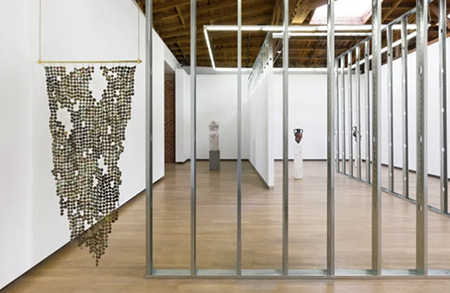
Continuing through October 28, 2023
For her exhibition “Monster in the Maze,” Cammie Staros has transformed the normal pathways of the gallery into a maze-like display consisting of bare metal studs and a number of new walls of mixed heights which direct the viewer's trajectory. This labyrinth not only segments the exhibition, but also allows for unusual sight lines and juxtapositions. As Staros presents three different kinds of works, all based on classical Greek artifacts (vessels, coins, marble sculptures), the display comments on the ways archeological relics and classical sculptures are presented in museums.
The vessels immediately stand out. Rather than being perfectly perpendicular and symmetrical, Staros' ceramic vases are morphed and askew, balanced on round, fluted, white columnar pedestals inset with shells and pebbles. For example, in “Attributed to: Human and Earth” the entire red-orange terra cotta vase is decorated with quasi-narrative bands of imagery depicting warriors, gods, and animals. These forms are painted in flat black and often outlined in white. The enchanting “Half Beast” appears like a dancing figure whose handles resemble tusks. This particular vessel is more subtly painted, covered with slightly lighter markings and patterns.
In contrast to these delicate ceramic forms, Staros also created a number of life-sized carved travertine sculptures that appear to be fragmented human figures. “Cora Kore” presents the bottom half of a draped figure on a rectangular limestone pedestal. The arm is cropped above the elbow and connected to nothing. The hand grabs hold of the folds of a robe or gown. The figure's neck and head are left to our imagination. A similar disorientation occurs in “Cult Classic,” Staros' abstracted and sensual representation of a partial torso. Though made of marble, these sculpted forms are etched with lines that give them an airiness while also alluding to flowing lava, melting ice, or running water.
The most delicate and fascinating works are coin "tapestries." To create these intricate pieces, Staros first cast and then glazed hundreds of irregular coin-shaped ceramics so they resemble ancient, corroded treasures. These were later assembled into expansive flat reliefs that are held together with thin bits of gold and silver wires and interspersed with elaborate and intricate web-like chains. Rather than all the coin works displayed on the walls, the largest, “Undercurrent” is suspended to function as another barrier along with the unfinished metal studs. The interweaving of the coins and spider webs draw parallels between presence and absence, past and present, and the fragility and vulnerability of living beings as symbolized by the seeming presence of ancient artifacts.
Staros looks to the precedent of classical sculptures from the Greco-Roman period to inspire much of her aesthetic. Her interest in these antiquities is formal as well as narrative, and she is mindful of how the past shapes the present and how what was depicted in Greco-Roman times can be recontextualized and reinterpreted today.
Her installations and individual works use this as a point of departure to comment on war, the gods, and mythologies. Staros pokes fun while also respectfully depicting imagery that might be found on ancient vessels. On one side of “Prize Amphora / Trophy Cup” for example, she paints five naked men who appear to be dancing across the distorted vase. On the other side, she includes three horses, two ridden by headless riders as the third rider gazes at the headless forms leading the way across the composition.
Staros' vessels, coin tapestries, and marble sculptures have a post-apocalyptic aura. She mines ancient forms, presenting the “Monster in the Maze," a maze of her own creation that simultaneously speaks to destruction and preservation.
